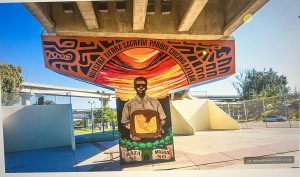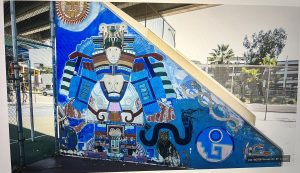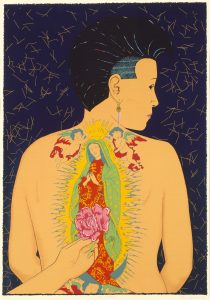Daniel Quinonez- Environmental Aspects of Chicano Art Portfolio

This shows the resilience of the Chicanos and their willingness to stay in their land and nature despite discrimination from Americans.
Jay Galvin by Flickr CC BY 2.0_ed

This mural shows the power of the colonizers and how they stole the land from the Mexicans.
Jay Galvin by Flickr CC BY 2.0_ed

This beautiful painting depicts the spiritual aspects of Chicano/a culture (Las Rosas & La Virgencita displayed on the back of the woman).
Ester Hernandez, La Ofrenda, from the National Chicano Screenprint Taller, Smithsonian American Art Museum, © 1988.
Preface
My name is Daniel Quinonez and my Portfolio as “Environmental Aspects of Chicano Art Portfolio”. The Creative Commons License I am using is CC BY-SA 4.0.
Introduction
This portfolio will be centered on the importance of the power of Chicano art and the influence it had on society. Chicano art represents and expresses the social and political movement of Mexican-Americans who fought for their rights, ability to express themselves freely and against discrimination to Mexican-Americans. Jay Galvin uses road infrastructure to express his art and to elevate the ability of people viewing his art and getting his message spread. Ester Hernandez creates abstract art, to signify strong aspects of Mexican culture, such as Rosas and La Virgen Guadalupe. Chicano art also has many environmental aspects. Some aspects are using art for gardens or even portraying art near green spaces. This art plays a part in conserving these green spaces.
Themes
There are many themes in this form of art. I’ll use Jay Galvin as an example. The first theme that is very evident in his art is that he uses infrastructure under highways and roads to display his art. There are many untouched spaces of grass and trees that are conserved as a result of the location of this art. He chooses to make his art in inconvenient locations in order to conserve the environment. The second theme is the use of vivid colors and nature to portray the land that was once theirs. They show that they won’t stand down to the land that was once theirs and they refuse to leave, even if they are continuously discriminated against. The illustration of Aztlan and its nature (cactuses and the heat) emphasizes the fact that Chicanos aren’t willing to leave their land no matter what as it is sacred to them.
Analysis
Chicano art is a form of art that resonates with millions of people in the United States. It signifies and resembles the hardships of Mexican-Americans living in the states, and the deep cultural aspects that are retained among Mexican families. Hardships that Mexican-Americans faced were discrimination, colonization of their land, and work harassment and belittlement. Discrimination and prejudice towards Mexicans and Latinos is still a major issue in the states up to this day, and art is a powerful way to express the feelings of the individuals discriminated against. Jay Galvin expresses this form of art through murals in an area in San Diego called Chicano Park. The two photos I’ve shown express some of the hardships Mexicans have had to face which include The one with predominantly blue color expresses the colonization of the Mexicans from the whites (Americans & Europeans). It also shows an Aztec like pyramid but with the faces of the colonizers which is a very interesting way to express this. Another one from Jay Galvin expresses the strength of the Mexican-Americans and their willingness to stay in their land, even if it’s not theirs anymore. Aztlan refers to a region in the United States that once belonged to Mexico. This includes California, Nevada, Colorado, Utah, Texas, New Mexico, and Arizona. It also exemplifies the impact on the environment this art has. Chicano Park is known for conserving the green spaces in the area, and it is all because of this art. If it weren’t for the art, the green spaces most likely wouldn’t be there anymore. Another famous artist among the Chicanos is Chicana artist Ester Hernandez. Her work reflects many themes that include political, spiritual, social, and ecological topics. The photo I have shown made by her expresses a more spiritual theme from her. It also shows how captivated Chicanos are with nature and conserving it. It portrays multiple aspects of Mexican culture. One detail shows there are roses as well as the traditional La Virgencita Guadalupe which is something that runs very deep in Mexican culture. There is also a book called “Ecological Borderlands: body, nature, and spirit in Chicana feminism”. This book explains the Ecological themes found in Chicano art, film, music, and much more. One important idea that resonated with the images of art I have shown is all the struggles of the Chicanos in the Southwest. It resonated with art because the struggles of Mexican-Americans are real, and it is shown in the art and explained in the book. It shows the loss of land, water, and resources. Many Chicanos or Mexicans in the US don’t have resources to live with stability. It’s very sad, but it is the reality of it. As someone who is Guatemalan and has been around Chicano culture a lot, the art portrayed by these people really have a powerful impact on us and the whole country, even ecological and environmental impacts. All in all, Chicano Art really shows all the struggles these individuals have to face, and they show it in a way that is beautifully expressed and conveyed that has the power to really touch one’s heart.
Application
Jay Galvin and other Chicanos/as such as Ester Hernandez convey their art in a way that is for the people. It suggests themes about the environment and the struggles of Mexican-Americans. Jay Galvin and his work really pushes the theme of the land that was once theirs and how they are discriminated against because they are different. His placement of the art also shows his efforts to conserve nature and hinder the rapid modernization of roads and infrastructure that damage nature itself. Ester portrays how in tune Mexicans are with nature, and how important nature is to the spiritual culture of Chicanos/as. You can see the important aspects these artists cover solely through their art, and the strong impact it has on people and the environment.

